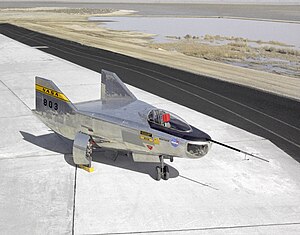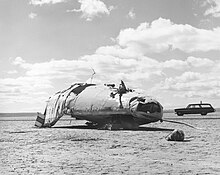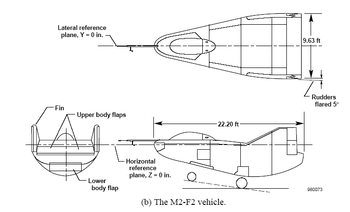The Northrop M2-F2 was a heavyweight lifting body based on studies at NASA's Ames and Langley research centers and built by the Northrop Corporation in 1966.
| M2-F2 | |
|---|---|
 | |
| Role | Lifting body technology demonstrator |
| National origin | United States |
| Manufacturer | Northrop |
| First flight | 12 July 1966 |
| Retired | 10 May 1967 |
| Status | Rebuilt as M2-F3 |
| Primary user | NASA |
| Number built | 1 |
| Developed from | NASA M2-F1 |
| Variants | Northrop M2-F3 |
Development
The success of Dryden's M2-F1 program led to NASA's development and construction of two heavyweight lifting bodies based on studies at NASA's Ames and Langley research centers—the M2-F2 and the HL-10, both built by the Northrop Corporation. The "M" refers to "manned" and "F" refers to "flight" version. "HL" comes from "horizontal landing" and 10 is for the tenth lifting body model to be investigated by Langley.
On March 23, 1966 the M2-F2 made its first captive flight—attached to the B-52 carrier aircraft throughout. The first free gliding flight of the M2-F2 was on July 12, 1966, piloted by Milton O. Thompson. He was dropped from the B-52 carrier aircraft's wing pylon at an altitude of 45,000 ft (14,000 m) and reached a speed of about 450 mph (720 km/h; 390 kn).
Operational history

Before powered flights were undertaken, a series of glide flights were conducted. On May 10, 1967, the sixteenth and last glide flight ended in disaster as the vehicle slammed into the lake bed on landing. With test pilot Bruce Peterson at the controls, the M2-F2 suffered a pilot induced oscillation (PIO) as it neared the lake bed. At the core of this problem was the fact that the wings of the M2-F2 (essentially the body of the aircraft) produced considerably less roll authority than most aircraft. This resulted in less force available to the pilot to control the aircraft in roll. The vehicle rolled from side to side in flight as he tried to bring it under control. Peterson recovered, but then observed a rescue helicopter that seemed to pose a collision threat. Distracted, Peterson drifted in a crosswind to an unmarked area of the lake bed where it was very difficult to judge the height over the ground because of a lack of guidance (the markers provided on the lake bed runway).[1]
Peterson fired the landing rockets to provide additional lift, but he hit the lake bed before the landing gear was fully down and locked. The M2-F2 rolled over six times, coming to rest upside down. Pulled from the vehicle by Jay King and Joseph Huxman, Peterson was rushed to the base hospital, transferred to the March Air Force Base Hospital and then the UCLA Hospital. He recovered but lost vision in his right eye due to a staphylococcal infection.
Portions of M2-F2 footage including Peterson's spectacular crash landing were used for the 1973 television series The Six Million Dollar Man[2] though some shots during the opening credits of the series showed the later HL-10 model, during release from its carrier plane, a modified B-52.
Four pilots flew the M2-F2 on its 16 glide flights. They were Milton O. Thompson (five flights), Bruce Peterson (three flights), Don Sorlie (three flights) and Jerry Gentry (five flights).[citation needed]
NASA pilots and researchers realized the M2-F2 had lateral control problems, even though it had a stability augmentation control system. When the M2-F2 was rebuilt at Dryden and redesignated the M2-F3, it was modified with an additional third vertical fin—centered between the tip fins to improve control characteristics.
The M2-F2/F3 was the first of the heavyweight, entry-configuration lifting bodies. Its successful development as a research test vehicle answered many of the generic questions about these vehicles.
M2-F2 flights
- NASA M2-F2 - NASA 803, 16 unpowered flights
| Vehicle Flight # | Date | Pilot | Mach | Velocity (km/h) | Altitude (meters) | Duration | Comments |
|---|---|---|---|---|---|---|---|
| M2-F2 #1 | July 12, 1966 | Thompson | 0.646 | 727 | 13,716 | 00:03:37 | First M2-F2 Flight. Unpowered glide. 320 km/h landing. |
| M2-F2 #2 | July 19, 1966 | Thompson | 0.598 | 634 | 13,716 | 00:04:05 | Unpowered glide. Determination of lateral stability control, longitudinal trim, vehicle performance and landing characteristics. |
| M2-F2 #3 | August 12, 1966 | Thompson | 0.619 | 692 | 13,716 | 00:04:38 | Unpowered glide. Determine effect of increasing Mach number, minimum damper requirements, testing of longitudinal and lateral stability and control. |
| M2-F2 #4 | August 24, 1966 | Thompson | 0.676 | 718 | 13,716 | 00:04:01 | Unpowered glide. Determine control damper requirements, lift-drag ratio, elevon response, flap effectiveness and longitudinal stability and control. |
| M2-F2 #5 | September 2, 1966 | Thompson | 0.707 | 750 | 13,716 | 00:03:46 | Unpowered glide. Evaluate 360 degree overhead approach, determine control damper-off handling qualities. |
| M2-F2 #6 | September 15, 1966 | Peterson | 0.705 | 750 | 13,716 | 00:03:30 | Unpowered glide. Pilot checkout. |
| M2-F2 #7 | September 20, 1966 | Sorlie | 0.635 | 678 | 13,716 | 00:03:31 | Unpowered glide. Pilot checkout. |
| M2-F2 #8 | September 22, 1966 | Peterson | 0.661 | 702 | 13,716 | 00:03:53 | Unpowered glide. Longitudinal and lateral stability and control with dampers. |
| M2-F2 #9 | September 28, 1966 | Sorlie | 0.672 | 713 | 13,716 | 00:03:53 | Unpowered glide. Complete pilot checkout and extend flight envelope. |
| M2-F2 #10 | October 5, 1966 | Sorlie | 0.615 | 692 | 13,716 | 00:03:45 | Unpowered glide. Explore lateral and longitudinal stability and control characteristics with dampers on and off. |
| M2-F2 #11 | October 12, 1966 | Gentry | 0.662 | 702 | 13,716 | 00:03:54 | Unpowered glide. Pilot checkout. |
| M2-F2 #12 | October 26, 1966 | Gentry | 0.605 | 642 | 13,716 | 00:03:47 | Unpowered glide. Obtain stability and control data at 7 and 11 degree attack angles and upper flap effectiveness. |
| M2-F2 #13 | November 14, 1966 | Gentry | 0.681 | 716 | 13,716 | 00:04:21 | Unpowered glide. Test stability and control, determine vehicle performance characteristics. |
| M2-F2 #14 | November 21, 1966 | Gentry | 0.695 | 735 | 13,716 | 00:03:50 | Unpowered glide. Test stability and control, determine vehicle performance characteristics. |
| M2-F2 #15 | May 2, 1967 | Gentry | 0.623 | 661 | 13,716 | 00:03:51 | Unpowered glide. |
| M2-F2 #16 | May 10, 1967 | Peterson | 0.612 | 649 | 13,716 | 00:03:43 | Unpowered glide Crash landing[3] |
Specifications (M2-F2)

Data from [citation needed]
General characteristics
- Crew: 1
- Length: 22 ft 2 in (6.76 m)
- Wingspan: 9 ft 8 in (2.95 m)
- Height: 9 ft 6 in (2.90 m)
- Wing area: 160 sq ft (15 m2)
- Empty weight: 4,620 lb (2,096 kg)
- Gross weight: 6,000 lb (2,722 kg)
- Max takeoff weight: 7,485 lb (3,395 kg)
- Powerplant: 1 × Reaction Motors XLR-11 liquid-fuelled rocket motor, 8,000 lbf (36 kN) thrust with four combustion chamber/nozzle assemblies
Performance
- Maximum speed: 405 kn (466 mph, 750 km/h)
- Maximum speed: Mach 0.707
- Range: 8.6 nmi (9.9 mi, 15.9 km)
- Service ceiling: 45,000 ft (14,000 m)
- Wing loading: 43.2 lb/sq ft (211 kg/m2)
- Thrust/weight: 1.3
See also
Aircraft of comparable role, configuration, and era
References
External links
